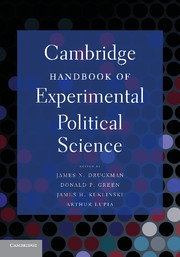Book contents
- Frontmatter
- Contents
- List of Tables
- List of Figures
- Contributors
- Acknowledgments
- INTRODUCTION
- PART I DESIGNING EXPERIMENTS
- PART II THE DEVELOPMENT OF EXPERIMENTS IN POLITICAL SCIENCE
- PART III DECISION MAKING
- PART IV VOTE CHOICE, CANDIDATE EVALUATIONS, AND TURNOUT
- PART V INTERPERSONAL RELATIONS
- PART VI IDENTITY, ETHNICITY, AND POLITICS
- PART VII INSTITUTIONS AND BEHAVIOR
- PART VIII ELITE BARGAINING
- PART IX ADVANCED EXPERIMENTAL METHODS
- 31 Treatment Effects
- 32 Making Effects Manifest in Randomized Experiments
- 33 Design and Analysis of Experiments in Multilevel Populations
- 34 Analyzing the Downstream Effects of Randomized Experiments
- 35 Mediation Analysis Is Harder Than It Looks
- AFTERWORD
- Name Index
- Subject Index
- References
33 - Design and Analysis of Experiments in Multilevel Populations
Published online by Cambridge University Press: 05 June 2012
- Frontmatter
- Contents
- List of Tables
- List of Figures
- Contributors
- Acknowledgments
- INTRODUCTION
- PART I DESIGNING EXPERIMENTS
- PART II THE DEVELOPMENT OF EXPERIMENTS IN POLITICAL SCIENCE
- PART III DECISION MAKING
- PART IV VOTE CHOICE, CANDIDATE EVALUATIONS, AND TURNOUT
- PART V INTERPERSONAL RELATIONS
- PART VI IDENTITY, ETHNICITY, AND POLITICS
- PART VII INSTITUTIONS AND BEHAVIOR
- PART VIII ELITE BARGAINING
- PART IX ADVANCED EXPERIMENTAL METHODS
- 31 Treatment Effects
- 32 Making Effects Manifest in Randomized Experiments
- 33 Design and Analysis of Experiments in Multilevel Populations
- 34 Analyzing the Downstream Effects of Randomized Experiments
- 35 Mediation Analysis Is Harder Than It Looks
- AFTERWORD
- Name Index
- Subject Index
- References
Summary
Randomized experiments, the most rigorous methodology for testing causal explanations for phenomena in the social sciences, are experiencing a resurgence in political science. The classic experimental design randomly assigns the population of interest into two groups, treatment and control. Ex ante these two groups should have identical distributions in terms of their observed and unobserved characteristics. Treatment is administered based on assignment, and by the assumptions of the Rubin causal model, the average effect of the treatment is calculated as the difference between the average outcome in the group assigned to treatment and the average outcome in the group assigned to control.
Randomized experiments are often conducted within a multilevel setting. These settings can be defined at the level at which the randomization occurs, as well as at the level at which the treatment is both directly and indirectly administered. These indirect effects most often occur as a result of social transmission of the treatment, which is particularly likely when the treatment consists of information. This chapter explores the implications of these multilevel settings to highlight the importance of careful experimental design with respect to random assignment of the population and the implementation of the treatment. There are potential problems with analysis in this context, and this chapter suggests strategies to accommodate multilevel settings. These problems are most likely to occur in field settings where control is lacking, although they can sometimes occur in other settings as well.
- Type
- Chapter
- Information
- Cambridge Handbook of Experimental Political Science , pp. 481 - 493Publisher: Cambridge University PressPrint publication year: 2011
References
- 4
- Cited by

